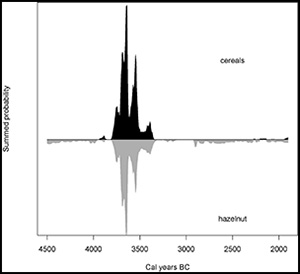Crossref Citations
This article has been cited by the following publications. This list is generated based on data provided by
Crossref.
Schulting, Rick J.
Mcclatchie, Meriel
Sheridan, Alison
Mclaughlin, Rowan
Barratt, Phil
and
Whitehouse, Nicki J.
2017.
Radiocarbon Dating of a Multi-phase Passage Tomb on Baltinglass Hill, Co. Wicklow, Ireland.
Proceedings of the Prehistoric Society,
Vol. 83,
Issue. ,
p.
305.
Bevan, Andrew
Colledge, Sue
Fuller, Dorian
Fyfe, Ralph
Shennan, Stephen
and
Stevens, Chris
2017.
Holocene fluctuations in human population demonstrate repeated links to food production and climate.
Proceedings of the National Academy of Sciences,
Vol. 114,
Issue. 49,
Treasure, Edward R.
Gröcke, Darren R.
Caseldine, Astrid E.
and
Church, Mike J.
2019.
Neolithic Farming and Wild Plant Exploitation in Western Britain: Archaeobotanical and Crop Stable Isotope Evidence from Wales (c. 4000–2200 calbc).
Proceedings of the Prehistoric Society,
Vol. 85,
Issue. ,
p.
193.
Colledge, Sue
Conolly, James
Crema, Enrico
and
Shennan, Stephen
2019.
Neolithic population crash in northwest Europe associated with agricultural crisis.
Quaternary Research,
Vol. 92,
Issue. 3,
p.
686.
Bradley, Richard
2019.
The Prehistory of Britain and Ireland.
de Vareilles, Anne
Pelling, Ruth
Woodbridge, Jessie
and
Fyfe, Ralph
2021.
Archaeology and agriculture: plants, people, and past land-use.
Trends in Ecology & Evolution,
Vol. 36,
Issue. 10,
p.
943.
Stolze, Susann
and
Monecke, Thomas
2021.
Neolithic land-use dynamics in northwest Ireland: multi-proxy evidence from Lough Arrow, County Sligo.
Vegetation History and Archaeobotany,
Vol. 30,
Issue. 3,
p.
423.
Roughley, Corinne
Twohig, Elizabeth Shee
Shell, Colin
and
Swanton, Gillian
2021.
Europe's Early Fieldscapes.
p.
115.
Griffiths, Seren
2022.
A Cereal Problem? What the Current Chronology of Early Cereal Domesticates Might Tell Us About Changes in Late Fifth and Early Fourth Millennium cal BC Ireland and Britain.
Environmental Archaeology,
Vol. 27,
Issue. 1,
p.
73.
McClatchie, Meriel
Schulting, Rick
McLaughlin, Rowan
Colledge, Sue
Bogaard, Amy
Barratt, Phil
and
Whitehouse, Nicki
2022.
Food Production, Processing and Foodways in Neolithic Ireland.
Environmental Archaeology,
Vol. 27,
Issue. 1,
p.
80.
Pigière, Fabienne
Smyth, Jessica
and
Biehl, Peter F.
2023.
First evidence for cattle traction in Middle Neolithic Ireland: A pivotal element for resource exploitation.
PLOS ONE,
Vol. 18,
Issue. 1,
p.
e0279556.



